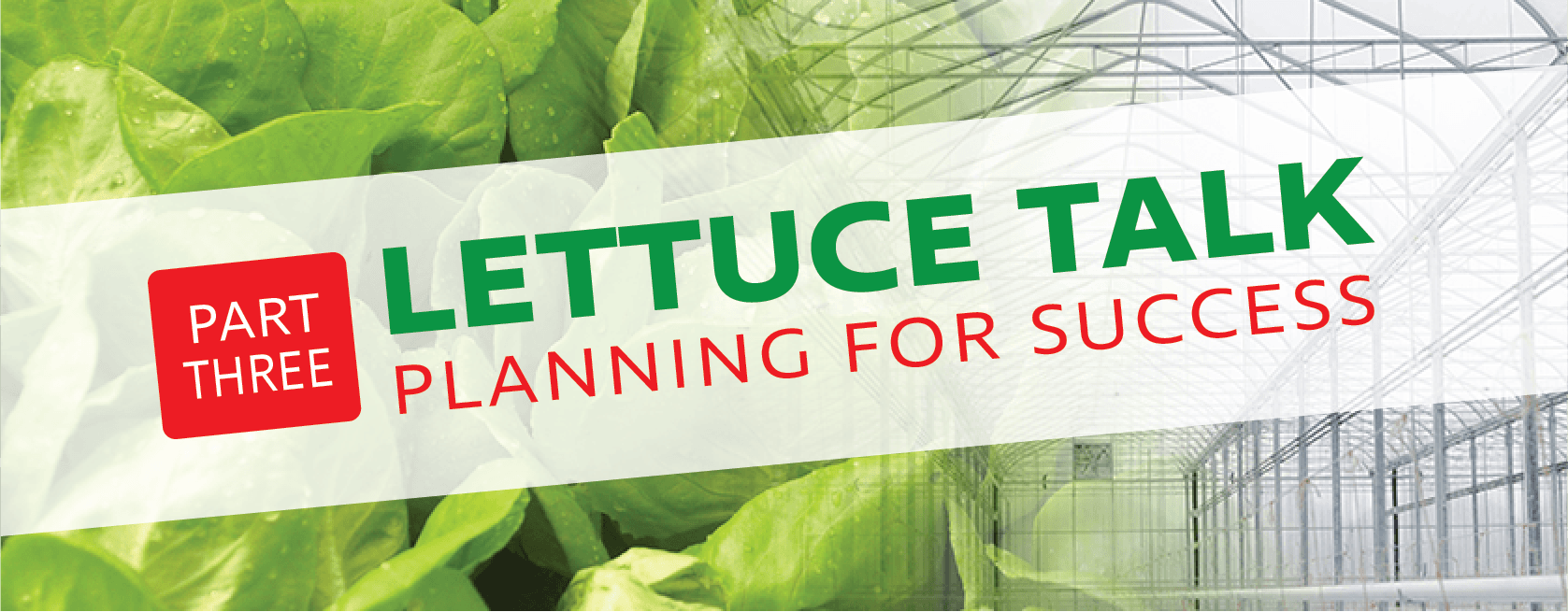Pulling the Plan Together for Successful Lettuce Growing in Greenhouse Production
From our perspective as greenhouse manufacturers specializing in greenhouse production and management, at GGS, this series of articles has covered most of the key inputs needed for setting up and preparing for greenhouse lettuce and leafy green production. We have a team of very experienced staff and partners that know how to plan and implement the manufacturing, construction, and management necessary for starting up greenhouse growing plans for a facility. There are a number of other factors that need to be considered, and additional expertise in greenhouse management is required to put it all together. If you are an established leafy green grower, especially in greenhouse lettuce production, you have been through this before, but if this is your first major greenhouse project, it is easy to miss a few details along the way.
By working closely with growers we have learned that there are variations to the standards and their input is valuable as part of the planning stage.
By working closely with growers, particularly in the greenhouse lettuce sector, we have learned that there are variations to the standards and their input is valuable as part of the greenhouse management and production planning stage.

So you have the land, and leafy greens, specifically greenhouse lettuce, is the plan for your new greenhouse production facility. Let's review the initial greenhouse management checklist. First, know the availability and cost to bring in the electrical lines adequate for a commercial greenhouse facility to your site for hook-up. Next, the two most common sources of energy for greenhouse management are natural gas or propane, and there will be a cost to have it on site and ready for greenhouse production. What is your water source for the greenhouse lettuce? The quantity, quality, and reliability of the water source are critical to greenhouse production. Have it tested so you know if you will need to include a treatment plan for it to be ready to use in the greenhouse for lettuce production. We have an irrigation questionnaire we can send to you that covers the questions you need to answer as part of planning a system that fits your greenhouse management needs. Contact us to receive this irrigation questionnaire for your greenhouse lettuce production. Contact us to receive this irrigation questionnaire.
GGS follows the National Farm Building code along with checking local climate conditions to ensure your greenhouse for lettuce production will stand up to the elements for years to come. Most importantly, you should check with your local municipality for any local building bylaws, setbacks, and permits that may affect your greenhouse management plans. You do not want to have an unexpected work stop order on the project partway through your greenhouse lettuce production journey.
Will you decide on a curved glass, poly carbonate or double poly for your greenhouse production? This is a preference and budget decision GGS can help with in the context of greenhouse management. We will go over the details with you, looking at the pros and cons of each for greenhouse lettuce and other productions. This is also an area where grower input helps in greenhouse production management. They are all good choices, and as discussed in the other article, there are a few variables each that need to be taken into account when planning greenhouse lettuce production. Read Part 1 of the Blog series to learn more about choosing the right structure
The choice of which hydroponic system you choose for your greenhouse lettuce is dependent on the size of the facility, preference of the grower, choice of leafy greens you are growing, level of automation, etc. As discussed in Part Two of this blog series, the two main choices are NFT, the trough system and Deep Water Culture, the large shallow pond and floating tray system, for optimal greenhouse management. We partner with companies that specialize in the various specific technology systems to ensure you get the options best suited to your needs in greenhouse production.
As part of planning and choosing the best products for you to produce in your greenhouse, start researching local markets and demand for greenhouse-grown lettuce. From microgreens to the various varieties of lettuce, the leafy green market for greenhouse-grown products is full of opportunities. Choose the best for you in greenhouse lettuce production.
An area hydroponic system provider will be able to give some guidance on post-harvest handling and packaging for greenhouse lettuce. What will catch the eye of the consumer on the shelf? How can you most efficiently and cost-effectively package your greenhouse produce?
The ability to know all the details required from planning and construction to growing and marketing will dictate how stressful or comfortable your leafy green project will progress and flourish in the realm of greenhouse management. At GGS, we look forward to working with you to get you started with the right greenhouse and environment for growing success in greenhouse lettuce production.
Ready to get your commercial greenhouse project started for optimal greenhouse lettuce production? Contact the experts at GGS today!
